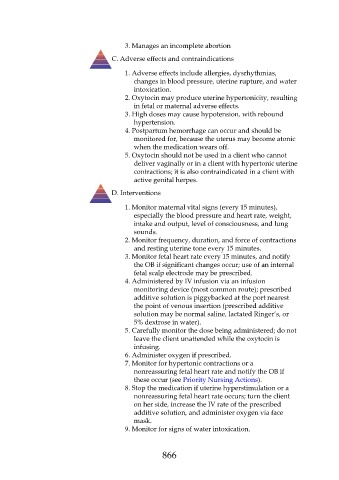Page 866 - Saunders Comprehensive Review For NCLEX-RN
P. 866
3. Manages an incomplete abortion
C. Adverse effects and contraindications
1. Adverse effects include allergies, dysrhythmias,
changes in blood pressure, uterine rupture, and water
intoxication.
2. Oxytocin may produce uterine hypertonicity, resulting
in fetal or maternal adverse effects.
3. High doses may cause hypotension, with rebound
hypertension.
4. Postpartum hemorrhage can occur and should be
monitored for, because the uterus may become atonic
when the medication wears off.
5. Oxytocin should not be used in a client who cannot
deliver vaginally or in a client with hypertonic uterine
contractions; it is also contraindicated in a client with
active genital herpes.
D. Interventions
1. Monitor maternal vital signs (every 15 minutes),
especially the blood pressure and heart rate, weight,
intake and output, level of consciousness, and lung
sounds.
2. Monitor frequency, duration, and force of contractions
and resting uterine tone every 15 minutes.
3. Monitor fetal heart rate every 15 minutes, and notify
the OB if significant changes occur; use of an internal
fetal scalp electrode may be prescribed.
4. Administered by IV infusion via an infusion
monitoring device (most common route); prescribed
additive solution is piggybacked at the port nearest
the point of venous insertion (prescribed additive
solution may be normal saline, lactated Ringer’s, or
5% dextrose in water).
5. Carefully monitor the dose being administered; do not
leave the client unattended while the oxytocin is
infusing.
6. Administer oxygen if prescribed.
7. Monitor for hypertonic contractions or a
nonreassuring fetal heart rate and notify the OB if
these occur (see Priority Nursing Actions).
8. Stop the medication if uterine hyperstimulation or a
nonreassuring fetal heart rate occurs; turn the client
on her side, increase the IV rate of the prescribed
additive solution, and administer oxygen via face
mask.
9. Monitor for signs of water intoxication.
866

